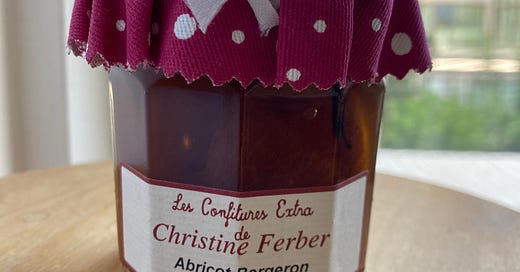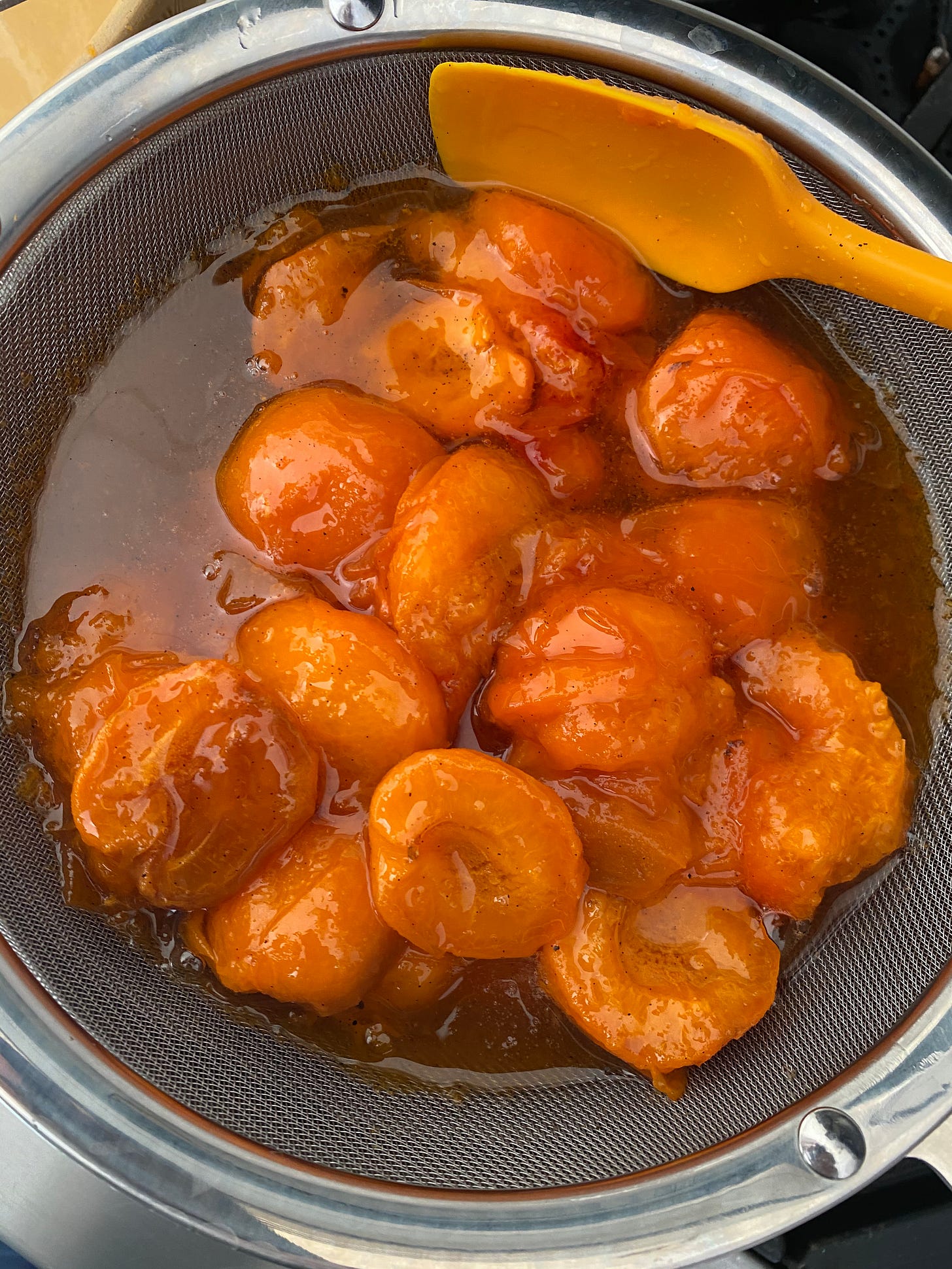Issue: #1: Jam Session: Making Christine Ferber's Apricot Vanilla Jam
Perfect for when you can't find a way to get to France to buy it.
Welcome to my first Kitchen Sense newsletter on substack.com. (Yes, I have jumped on the bandwagon.) After trying to publish recipes on Instagram for some of the dishes I cook, eat, photograph, and post, I became frustrated by the character limit, as well as the difficulty of saving, searching and sharing recipes on that platform. So this is how I intend to publish recipes I think you might want to…er…should cook. In this format I can give you all of the tips and tricks and kitchen sense I’ve learned over my years of cooking without having to cut things short. If you enjoy it, please share. Tell your friends. The featured recipes will be sent to all subscribers, about once a week. If you are moved to pay, thank you. Paid subscribers will have access to the entire archive and can engage with me directly. They may get bonus recipes. And they can feed me their questions, requests, cravings. Thanks for joining the Kitchen Sense community. Happy cooking.
I’ve been a fan of Christine Ferber’s jams ever since I stumbled on the Alsatian confiture queen’s line of custom flavors in a Poilâne bakery in Paris maybe 15 years ago. After tasting one I bought a half dozen bottles on the spot, and then a few days later when we stumbled on a display of her regular line at the Grande Épicerie in Le Bon Marché, I bought a dozen more. Her flavors are pure and deep, her combinations exciting. My first taste of her raspberry–violet was a revelation. My husband Nate eats her <<Abricot Bergeron et Vanille>> jam out of the jar with a spoon. But as a long-time jam maker myself, it’s her textures I find most surprising—almost creamy, custardy, achieved somehow without anything besides the most basic ingredients. For my taste, they are without rival.
So I was so excited when I came across a paperback edition of her jam book, Mes Confitures, in a shop in Paris. The recipes were simple, sparse. For a few, you were instructed to pick the fruit in the morning and keep the dew on the berries. Um…okay. Later, when the English edition came out in 2002, translated by Virginia Phillips, I got a copy of that one too. I appreciated that it was more or less identical to the original. I cross reference both whenever I try something new. I recommend them.
Over the years I have tried many of the recipes. Her technique generally involves a two-day approach: macerating the fruit, sugar and flavorings. Simmering that mixture. Chilling it overnight. And then the next day, simmering it all again to the correct jell point before canning. The results don’t all taste to me like the jams of hers we buy. (Maybe I need to live near a forest and find fruit with more dew on it.) But they are good. (I think the texture comes from her technique, which expresses maximum pectin, and the high proportion of sugar.) The one recipe I keep coming back to is this apricot-vanilla beauty. It has become our “house jam,” that is, it’s the one I make all summer long and preserve in quart-size jars, with only a few smaller jars for gifts. My husband is unwilling to share this jam except with our closest friends or people we are trying to impress. I don’t really change anything from the original recipe, except that having made it so often and in such large quantities I have learned to watch for a few things and adjust the times and temperatures accordingly. Here’s how I do it…
RECIPE: Christine Ferber’s Apricot–Vanilla Jam
I use a digital scale and metric measurements to be sure that I get things just right, or at least as close to what they might be were I making this jam in France.
1,150 g small, sweet, ripe apricots (about 2 1/2 pounds), rinsed, halved, and pitted
800 g sugar (about 3 3/4 cups)
200 g/ml water (about 7/8 cup)
Juice of 1 small lemon (about 3 tablespoons)
2 vanilla beans, split and scraped
In a large bowl, combine the apricot halves, sugar, water, lemon juice, and vanilla beans (pods and seeds). Stir to coat the fruit with sugar. Cover with plastic or parchment and let sit at room temperature for an hour.
Transfer the apricot mixture to a wide saucepan. Be sure to scrape out any sugar or vanilla seeds that’re stuck to the bowl. Over medium-high heat, bring the mixture to a simmer and let cook for 2 minutes. Pour this back into the bowl (no need to clean it), re-cover, and let cool to room temperature. Set in the refrigerator to chill, covered, overnight. I don't clean the saucepan yet, either.
Next day, place a large sieve over the same saucepan and dump the chilled contents of the bowl into it to drain the syrup from the fruit. Set the bowl down nearby and have another small container on hand. While the syrup drains, with the aid of a small spatula or tongs, pick up the apricots halves one at a time, skin side up, and using your opposite hand, pinch the skin to remove it from flesh. Toss the skin in the small container and place the soft, plump apricot flesh back in the large bowl. Some skins will just slip off easily. Others will be more stubborn. Tug or cut, if necessary. The more ripe your fruit, the easier this step will be. Some halve will have disintegrated beyond recognition. Fish out any skins you see from the sieve and transfer to the container. Don’t worry if bits of skin are left behind on the flesh. It will all be wonderful.
When all of the apricot skins are removed, press whatever’s left in the strainer through with a wooden spoon or spatula. Get every bit of syrup you can, including any that’s pooled in the bowl with the flesh or the container with the skins. Save the container with the skins in the fridge to eat on toast with ricotta for breakfast the next day. Or mix it into a pound cake. Or spoon it on vanilla ice cream. Don't let this go to waste.
Now, bring the pot of syrup up to a boil and keep cooking until it concentrates and reaches 222°F. on an instant-read thermometer. It will boil up high in the pot and then settle down. Once that temperature is reached, add the apricot halves and stir to distribute. Bring back to a simmer, lower the heat, and let cook gently 5 or 6 minutes, until nicely set. While simmering, skim any of the orange froth that forms on top of the mixture. I add this to my container of apricot skins and eat it all the next day.
Turn off the heat and let settle for 4 or 5 minutes. Divide the jam among clean, sterilized jars. I cut the vanilla bean pods into 1” or 2” pieces and add one to each of the jars. Clean the rims, cover, and process for about 7 minutes in boiling water, or however you process your jams for long-term storage. Of course you can just keep it all in the fridge so you don’t have to process it at all.
Pro tip: Before cleaning the pot, wipe it clean with torn pieces of fresh challah and eat them when no one else is looking.





